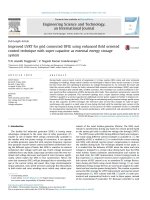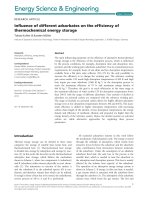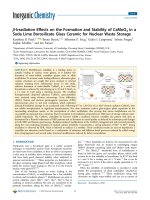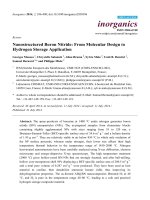VSICM6 m06 storage
Bạn đang xem bản rút gọn của tài liệu. Xem và tải ngay bản đầy đủ của tài liệu tại đây (8.27 MB, 95 trang )
Configuring and Managing Virtual Storage
Module 6
© 2015 VMware Inc. All rights reserved.
You Are Here
1. Course Introduction
7. Virtual Machine Management
2. Software-Defined Data Center
8. Resource Management and
3. Creating Virtual Machines
4. vCenter Server
5. Configuring and Managing
Virtual Networks
6. Configuring and Managing
Virtual Storage
Monitoring
9. vSphere HA and vSphere Fault
Tolerance
10. Host Scalability
11. vSphere Update Manager and
Host Maintenance
12. Installing vSphere Components
VMware vSphere: Install, Configure, Manage
© 2015 VMware Inc. All rights reserved.
6-2
Importance
Storage options give you the flexibility to set up your storage based on
your cost, performance, and manageability requirements.
Shared storage is useful for disaster recovery, high availability, and
moving virtual machines between hosts.
VMware vSphere: Install, Configure, Manage
© 2015 VMware Inc. All rights reserved.
6-3
Module Lessons
Lesson 1:
Storage Concepts
Lesson 2:
iSCSI Storage
Lesson 3:
NFS Datastores
Lesson 4:
VMFS Datastores
Lesson 5:
Virtual SAN Datastores
Lesson 6:
Virtual Volumes
VMware vSphere: Install, Configure, Manage
© 2015 VMware Inc. All rights reserved.
6-4
Lesson 1:
Storage Concepts
6-5
© 2015 VMware Inc. All rights reserved.
Learner Objectives
By the end of this lesson, you should be able to meet the following
objectives:
ã Describe VMware vSpheređ storage technologies and datastores
• Describe the storage device naming convention
VMware vSphere: Install, Configure, Manage
© 2015 VMware Inc. All rights reserved.
6-6
Basic Storage Overview
ESXi
Hosts
Datastor
e
Types
VMFS
NFS
File
System
Storage
Technologies
Direct
Attached
Fibre
Channel
FCoE
iSCSI
VMware vSphere: Install, Configure, Manage
© 2015 VMware Inc. All rights reserved.
NAS
6-7
Storage Protocol Overview
Storage
Protocol
Boot from
SAN
Support
vSphere
vMotion
Support
vSphere HA
Support
vSphere
DRS
Support
Raw Device
Mapping
Support
Fibre
Channel
●
●
●
●
●
FCoE
●
●
●
●
●
iSCSI
●
●
●
●
●
NFS
●
●
●
DAS
●
Virtual
Volumes
●
●
●
Virtual SAN
●
●
●
●
VMware vSphere: Install, Configure, Manage
© 2015 VMware Inc. All rights reserved.
6-8
About Datastores
A datastore is a logical storage unit
that can use disk space on one
physical device or span several
physical devices.
Types of datastores:
ã VMware vSpheređ VMFS
Host
Host
ã NFS
Datastores are used to hold virtual
machine files, templates, and ISO
images.
Datastore
VMware vSphere: Install, Configure, Manage
© 2015 VMware Inc. All rights reserved.
6-9
About VMFS5
VMFS5:
• Allows concurrent access to
shared storage.
• Can be dynamically expanded.
• Uses a 1 MB block size, good
for storing large virtual disk
files.
Host
Host
• Uses subblock addressing,
good for storing small files: the
subblock size is 8 KB.
• Provides on-disk, block-level
locking.
VMFS Datastore
VMware vSphere: Install, Configure, Manage
© 2015 VMware Inc. All rights reserved.
6-10
About NFS
NFS:
• Is storage shared over the
network at the file system level
• Supports NFS version 3 and
4.1 over TCP/IP
Host
Host
NFS Datastore
VMware vSphere: Install, Configure, Manage
© 2015 VMware Inc. All rights reserved.
6-11
About Raw Device Mapping
Virtual Disk
RDM enables you to
store virtual machine
data directly on a LUN.
RDM
The mapping file is
stored on a VMFS
datastore that points to
the raw LUN.
-flat.vmdk
.vmdk
-rdm.vmdk
VMFS or NFS
VMFS
.vmdk
Raw
LUN
NTFS/ext4
VMware vSphere: Install, Configure, Manage
© 2015 VMware Inc. All rights reserved.
6-12
Virtual SAN Overview
Virtual SAN
vSphere
3-64
SSD
HD/SSD
SSD
HD/SSD
SSD
HD/SSD
Virtual SAN Aggregated Datastore
VMware vSphere: Install, Configure, Manage
© 2015 VMware Inc. All rights reserved.
6-13
About Virtual Volumes
Overview
• Native representation of VMDKs on
vSphere
vSphere
SAN/NAS: No LUNs or volume management.
Virtual
Virtual Volumes
Volumes
• Works with existing SAN/NAS systems.
• A new control path for data operations at the
PE
VM/VMDK level.
• Snapshots, replications, and other operations
at the VM level on external storage.
Replication
Snapshots
Caching
• Automates control of per-VM service levels.
• Protocol endpoint provides standard protocol
Encryption
Deduplication
access to storage.
• Storage containers can span an entire array.
VMware vSphere: Install, Configure, Manage
© 2015 VMware Inc. All rights reserved.
6-14
Storage Device Naming Conventions
Storage devices are identified in several ways:
• Runtime name: Uses the convention vmhbaN:C:T:L. This name is not
persistent through reboots.
• Target: Identifies iSCSI target address and port.
• LUN: A unique identifier designated to individual or collections of hard disk
devices. A logical unit is addressed by the SCSI protocol or SAN protocols that
encapsulate SCSI, such as iSCSI or Fibre Channel.
VMware vSphere: Install, Configure, Manage
© 2015 VMware Inc. All rights reserved.
6-15
Physical Storage Considerations
You should discuss vSphere storage needs with your storage
administration team, including the following items:
• LUN sizes
• I/O bandwidth
• I/O requests per second that a LUN is capable of
• Disk cache parameters
• Zoning and masking
• Identical LUN presentation to each VMware ESXi™ host
• Active-active or active-passive arrays
• Export properties for NFS datastores
VMware vSphere: Install, Configure, Manage
© 2015 VMware Inc. All rights reserved.
6-16
Review of Learner Objectives
You should be able to meet the following objectives:
ã Describe VMware vSpheređ storage technologies and datastores
ã Describe the storage device naming convention
VMware vSphere: Install, Configure, Manage
© 2015 VMware Inc. All rights reserved.
6-17
Lesson 2:
iSCSI Storage
6-18
© 2015 VMware Inc. All rights reserved.
Learner Objectives
By the end of this lesson, you should be able to meet the following
objectives:
• Describe uses of IP storage with ESXi
• Describe iSCSI components and addressing
• Configure iSCSI initiators
VMware vSphere: Install, Configure, Manage
© 2015 VMware Inc. All rights reserved.
6-19
iSCSI Components
VMware vSphere: Install, Configure, Manage
© 2015 VMware Inc. All rights reserved.
6-20
iSCSI Addressing
iSCSI target name:
iqn.1992-08.com.mycompany:stor1-47cf3c25
or
eui.fedcba9876543210
iSCSI alias: stor1
IP address: 192.168.36.101
iSCSI initiator name:
iqn.1998-01.com.vmware:train1-64ad4c29
or
eui.1234567890abcdef
iSCSI alias: train1
IP address: 192.168.36.88
VMware vSphere: Install, Configure, Manage
© 2015 VMware Inc. All rights reserved.
6-21
iSCSI Initiators
VMware vSphere: Install, Configure, Manage
© 2015 VMware Inc. All rights reserved.
6-22
Setting Up iSCSI Adapters
You set up software or hardware adapters before an ESXi host can work
with a SAN.
Supported iSCSI adapter types (vmhba):
•
Software adapter
•
Hardware adapter:
•
Independent hardware adapter
•
Dependent hardware adapter
VMware vSphere: Install, Configure, Manage
© 2015 VMware Inc. All rights reserved.
6-23
ESXi Network Configuration for IP Storage
A VMkernel port must
be created for ESXi to
access software iSCSI.
The same port can be
used to access
NAS/NFS storage.
To optimize your
vSphere networking
setup, separate iSCSI
networks from
NAS/NFS networks:
• Physical separation is
preferred.
• If physical separation is
not possible, use
VLANs.
VMware vSphere: Install, Configure, Manage
© 2015 VMware Inc. All rights reserved.
6-24
Creating Datastores and Discovering iSCSI Targets
Based on the environment
and storage needs, you can
create VMFS, NFS, or virtual
datastores as repositories for
virtual machines.
The iSCSI adapter discovers
storage resources on the
network and determines which
ones are available for access.
192.168.36.101:3260
An ESXi host supports the
following discovery methods:
• Static
• Dynamic, also called
SendTargets
Request
SendTargets
Response
SendTargets
The SendTargets response iSCSI Target:
192.168.36.101:3260
returns the IQN and all
available IP addresses.
VMware vSphere: Install, Configure, Manage
© 2015 VMware Inc. All rights reserved.
6-25









